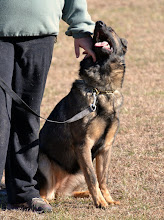In German Shepherds, a "bicolor" is a tanpoint dog -- where
the tan doesn't extend beyond the typical "points" that you see in many
breeds. The
masking gene and the black recessive are what make a tanpoint GSD
be marked differently from, say, a tanpoint rottweiler or doberman or Manchester terrier or black-tan coonhound.
 |
| Blackthorn's Coal, BH |
In GSDs, you can tell a bicolor dog from a dark black and tan (blanket back) by the following characteristics:
- toemarks
- tarheels
- no tan around the barrel of the chest
 |
| Blackthorn's Jedi (full brother to Coal) |

Some bicolor GSDs carry the black recessive, which causes heavier black coloring, some carry modifiers for heavier masking.
If a dog has fewer modifiers for masking, the tanpoint/bicolor dog
might have tan eyebrows, tan points on the chest, or tan cheek marks.
In order to get the saddle pattern (seen in beagles as well as GSDs, for example), you need to have at least one copy of the "creeping tan" gene, a modifier gene that causes the tan areas of the dog to expand as the dog matures. The tan continues to "creep" throughout the dog's life, so that a 10 year old will have less black coverage than a 1 year old.
 |
| Blackthorn's Bright Heart, CDX, Sch3, CGC |
A regular tanpoint GSD with 2 tanpoint genes (no black recessive) and no modifiers might look similar to Hunter.
 |
| Blackthorn's Hunter, JHD |
Note that Hunter has toemarks and tarheels and no tan around the barrel of her chest.
 |
| Hunter |
A tanpoint with 1 copy of the creeping tan gene with no black recessive might look like Nike. She had 1 copy of the modifier gene -- she produced saddles/blanket backs (Jubilee) and bicolors (Hunter, Coal, Jedi, among others) -- but never a solid black puppy.
 |
"Nike" - Ike v Del U Haus, Sch2, and "Quin" Hellequin v Eichenluft, Sch3
Nike = tanpoint/tanpoint, 1 copy of creeping tan
Quin = tanpoint/black, 1 copy of creeping tan |
A tanpoint with 1 copy of the creeping tan gene with the black recessive will look like Xita or Jubilee or Xan. These are often called "blanket back" black and tans. Notice how all of these dogs have no tarheels or toemarks--and they all have some tan under the barrel of their chest. Other typical features are shaded-tan areas on their cheeks and tan behind and inside their ears.
 |
| V-Xita vom Ludwigseck, IPO1, Kk1a |
 |
| Notice how Xita gained more brown/tan as she matured. |
 |
Blackthorn's Jubilee, CD, HS, RA, JHD |
 |
| Blackthorn's Xanthippe |
A tanpoint with 2 copies of the creeping tan gene will have a saddle pattern, even if the dog carries the black recessive. Usually, this will be a darker saddle--less than a blanket back, but more than the most common saddle pattern. It can be hard to tell the difference between bicolor and a "blanket back" black/tan dog when they are puppies.
 |
| Jubilee at 8 weeks old -- toemarks starting to fade. |
A puppy with the black recessive may have toemarks as puppies and they won't always have much black on their face. The toemarks may remain until the dog is as much as a year old--but they will fade once the dog is an adult.
 |
| Bicolor and saddle-back pups at about 10 weeks |
Here are some examples of bicolor and black/tan pups at about 7-10 weeks old.
 |
| This girl grew up to be a bicolor. |
 |
Both of these girls grew up to be bicolors. |
 |
| Black-tan (blanket back) |
 |
| This dark boy lost his toemarks and is a "blanket back" as an adult. |
 |
| Baby Xan - "blanket back" |
 |
This girl looks like a "blanket back" at 2 years old,
but I think she will end up looking like her grandmother Nike. |
The degree of masking will also play a big factor in how dark any of these dogs will be. Note that a tanpoint with 2 copies of creeping tan (so, your typical saddle-back dog, with a small saddle that doesn't cover the shoulders) will never produce bicolor because every one of his/her pups will carry at least a single copy of creeping tan.
I am pretty sure that a black dog or a sable dog can carry the creeping tan modifier. I have had sable dogs who produce no black dogs, but only bicolor when the pup inherits black from one parent and sable from the other. Danca produced sables and bicolors, never black pups when bred to my Coal (who was tanpoint with the black recessive).
 |
| Danca v Leibnitz, Sch1 - she had light tarheels and toemarks. |
Dance produced my M and L litters out of Coal -- the pups were bicolors and sables.
 |
| Lynx and Musket |
A sable who carries "saddle" tanpoint will have a saddle-like pattern and will not have toemarks.
 |
| Frostbite v. Pantara, Sch1, KK2 |
A homozygous sable (sable/sable) will usually have toemarks, but I haven't seen enough to know whether they always dog. These dogs will only produce sable pups (when breeding "standard" color GSDs).
 |
Acky vd Neuen Lande, SchH3
homozygous sable, very richly pigmented.
I think he had very faint toemarks, but my pictures are of poor quality,
and it's hard to tell. |


 Some bicolor GSDs carry the black recessive, which causes heavier black coloring, some carry modifiers for heavier masking.
Some bicolor GSDs carry the black recessive, which causes heavier black coloring, some carry modifiers for heavier masking. 

























